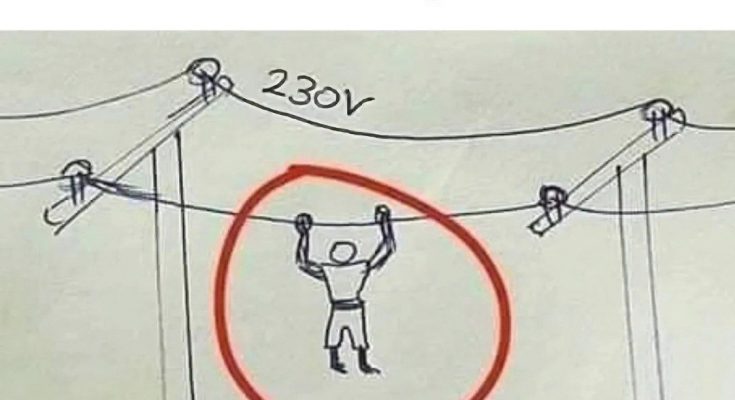We often see birds perched calmly on electrical wires without a hint of discomfort, which raises an interesting question: if a person were to hang on a live wire with both hands, would they get shocked? Understanding this scenario requires a bit of insight into how electricity flows and why certain conditions allow for safe contact with live wires, while others result in serious injury. Let’s dive into the science behind electric currents and find out what really happens in such situations.

How Electricity Flows: The Basics of Electrical Circuits
To understand whether someone would be shocked while hanging on a live wire, it’s important to grasp the fundamentals of electricity. Electrical current flows in circuits, moving from a power source, through conductors, and eventually back to its origin. For electricity to flow through any object or person, it must complete a circuit—meaning it needs an entry and exit point to travel from and return to.
When a bird perches on a single electrical wire, it doesn’t complete a circuit because there’s no other point of contact for the electricity to travel through. This keeps the bird safe from electric shock, and this principle is similar when it comes to a person hanging from a live wire. However, there’s more to the story, as certain conditions can make the difference between safety and severe harm.
Will Hanging on a Live Wire Cause Electric Shock?
If a person hangs on a live wire with both hands and has no other point of contact—such as the ground or another wire—they might not be shocked. This is because, like the bird, they don’t complete the electrical circuit. The electric current will continue to flow within the wire itself rather than traveling through the person’s body. Without a second point of contact to form an exit path, the electricity has no reason to divert from its path in the wire.
In essence, while holding onto a single live wire without touching anything else, there is no circuit for the electricity to follow through the body. The person remains insulated from the flow, which is why they wouldn’t experience a shock in this controlled situation. However, this does not make the situation safe by any means.
Why Safety Risks Still Exist: Unpredictable Factors and Human Error
While hanging from a live wire might seem safe in theory, real-life circumstances introduce serious risks. Even the smallest miscalculation or unintended movement could lead to accidental contact with a secondary object—whether it’s the ground, a tree, or another wire. The instant a second point of contact is made, a pathway for electricity to flow through the person’s body is created, and this would result in an immediate and potentially fatal electric shock.
In cases where both a live wire and the ground are involved, electricity flows from the high-voltage line, through the body, and into the ground. The human body, being conductive, allows electricity to pass through, which can cause injuries ranging from severe burns to fatal electrocution.

Why Birds Don’t Get Shocked While Perching on Wires
Birds perched on power lines provide a natural example of how staying on a single conductor prevents electric shock. Birds don’t complete the electrical circuit because they aren’t touching another conductive object simultaneously. Furthermore, birds have less surface area and make minimal contact with the wire, reducing their risk. Since there’s no conductive exit point, the electric current stays within the wire and bypasses the bird entirely.
In contrast, if a bird were to touch another wire or grounded object while on a live wire, the current would flow through its body, resulting in electrocution. This is why birds are often safe on wires but at risk when wires are close together, or when they accidentally touch another object that allows electricity to complete its path.
Human Scenarios Where Electric Shock Risks Increase
While birds make it look easy, humans face more complex variables when near live wires. For a person, even subtle changes in position, movements, or unexpected shifts can introduce secondary points of contact. Some risky scenarios include:
- Accidentally Touching Another Wire – If a person hanging from a live wire inadvertently makes contact with another wire (either live or grounded), they would immediately form a circuit and experience an electric shock.
- Proximity to Ground or Other Objects – The closer a person is to the ground or grounded objects, the higher the chance of accidental contact, which could result in a pathway for electricity through the body.
- Conductive Materials – Wearing or carrying conductive materials, such as metallic items or damp clothing, can make a person more susceptible to shock if they get close to a secondary point of contact.

Why Trained Professionals Still Exercise Extreme Caution
Even trained professionals, such as linemen, take extensive precautions when working with electrical wires. Specialized equipment, insulated clothing, and meticulous protocols are used to ensure that no unintended circuit paths are formed. Hanging from live wires without protective equipment or thorough knowledge of electrical currents is incredibly dangerous and can lead to life-threatening injuries. Professional electricians and linemen undergo rigorous training to understand the risks and follow safety protocols designed to minimize accidental contact with other conductive objects.
Key Takeaways: Why Staying Clear of Live Wires Is Essential
Although, in theory, a person hanging from a single live wire might not get shocked, this situation is anything but safe. The risks associated with unintended contact or human error far outweigh any momentary sense of security. Electricity is highly unpredictable, and without professional equipment, exposure to live wires is not worth the gamble. Here’s why staying clear of live wires is always the best option:
- Uncontrolled Environment – Unlike controlled lab settings, outdoor electrical wires present multiple uncontrolled variables, such as wind, movement, or objects nearby.
- Accidental Contact Risk – Even the slightest accidental contact can create a circuit, resulting in immediate and severe consequences.
- High Voltage Danger – Electrical currents in live wires are extremely powerful, and exposure to high voltage can cause fatal injuries almost instantly.
- Lack of Protective Measures – Professionals working with live wires use specialized gear and follow strict protocols. For an unprotected individual, the risks are exponentially greater.
Conclusion: Respect Electricity, Respect Safety
So, can a person hang on a live wire without getting shocked? Technically, yes, if they only hold onto the single wire and avoid all other contact points. But practically speaking, it’s a highly dangerous scenario due to the unpredictability of real-world environments and the high risk of accidental contact. Unlike birds, humans cannot rely on a safe experience when dealing with live wires, as even the smallest mistake could lead to catastrophic consequences.
The moral of the story? Respect the power of electricity and prioritize safety. Whether you’re curious or simply want to understand more about how electrical currents work, remember that no theoretical insight is worth the risk of physical exposure. Always stay far from live wires, and if you encounter electrical work, leave it to the trained professionals equipped to handle it safely.



